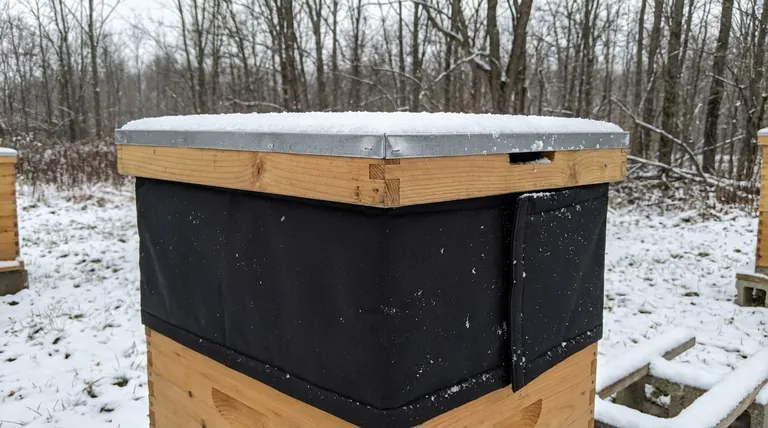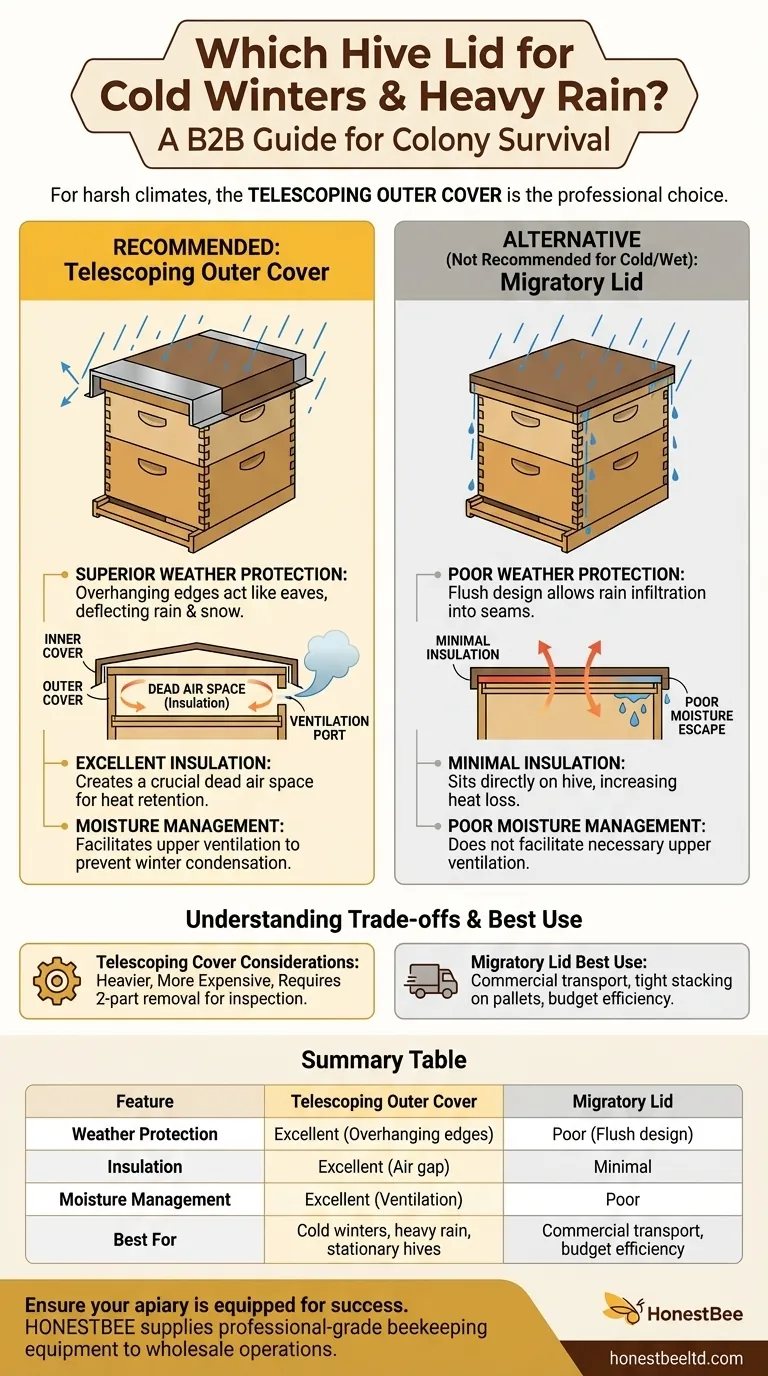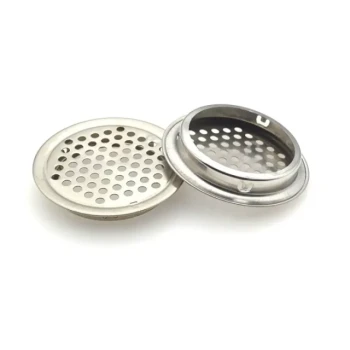For beekeepers in regions with cold winters or heavy rain, the telescoping outer cover is the standard and most effective choice. This design features sides that hang down over the top hive body, creating a protective shield that directs rain away from the hive's sensitive joints and provides a crucial buffer against cold air.
The core challenge in harsh climates isn't just keeping rain out; it's managing the hive's internal moisture and temperature. The telescoping outer cover is not just a lid, but a key component of a system designed to keep the colony dry and insulated.

Why the Telescoping Cover Excels in Harsh Weather
A hive cover seems simple, but its design has a profound impact on the colony's ability to survive environmental stress. The superiority of the telescoping cover comes down to two key functions: weather deflection and insulation.
Superior Weather Protection
The defining feature of a telescoping cover is its "telescoping" design. The edges of the lid extend down several inches over the top of the uppermost hive box.
This overhang acts like the eaves on a house, preventing rain and snowmelt from seeping into the vertical seams between hive components. Most are also capped with metal for maximum durability and water resistance.
Creating an Insulating Air Gap
The telescoping cover is designed to be used with an inner cover. This creates a pocket of trapped air between the inner cover and the outer cover.
This "dead air space" is a highly effective insulator, reducing heat loss from the top of the hive where it's needed most. It helps the colony maintain its crucial winter cluster temperature with less effort and lower food consumption.
Facilitating Upper Ventilation
Moisture, not cold, is often the biggest killer of colonies in winter. A bee cluster releases a significant amount of warm, moist air through respiration.
The inner cover typically has a notched rim that creates a small upper entrance or ventilation port. This allows excess moisture to escape the hive instead of condensing on a cold surface and dripping back down onto the bees. The telescoping cover protects this vent from rain.
Understanding the Alternatives and Their Limitations
To understand why the telescoping cover is recommended, it's useful to compare it to the primary alternative.
The Migratory Lid
The migratory lid is a flat, simple cover that sits flush with the dimensions of the hive body. It has no overhanging edges.
Its name comes from its purpose: commercial beekeepers who migrate their hives for pollination use these lids because they are lightweight and allow hives to be stacked tightly together on pallets and trucks.
Why Migratory Lids Fall Short
For a stationary hive in a wet or cold climate, the migratory lid is a poor choice. Its flush design allows rain to run directly down the side of the hive and into the seams.
Furthermore, it offers minimal insulation, as it sits directly on the top bars or hive body with no insulating air gap. This makes it much harder for the colony to regulate its temperature.
Understanding the Trade-offs
While superior for protection, the telescoping cover system is not without its considerations. Acknowledging these trade-offs is key to making an informed decision.
Cost and Weight
A telescoping outer cover, especially when paired with a required inner cover, is heavier and more expensive than a single migratory lid. The construction is more complex and uses more material.
Inspection Inconvenience
During a hive inspection, you must remove two pieces (the outer and inner cover) instead of one. While a minor difference, it adds a step to the process.
Making the Right Choice for Your Hive
Your choice of hive cover should be directly aligned with your climate and beekeeping goals. It is one of the most important equipment decisions for ensuring colony health.
- If your primary focus is maximum weather protection and winter survival: The telescoping outer cover used with an inner cover is the only professionally recommended choice.
- If your primary focus is commercial-scale transport and budget efficiency: The migratory lid is the industry standard, but you must accept its significant limitations in weather protection.
Ultimately, a successful hive is a dry hive, and your choice of cover is the first and most important line of defense.
Summary Table:
| Feature | Telescoping Outer Cover | Migratory Lid |
|---|---|---|
| Weather Protection | Excellent (overhanging edges) | Poor (flush design) |
| Insulation | Excellent (creates an air gap) | Minimal |
| Moisture Management | Excellent (facilitates upper ventilation) | Poor |
| Best For | Cold winters, heavy rain, stationary hives | Commercial transport, budget efficiency |
Ensure your apiary is equipped for success in any climate. The right equipment is critical for colony health and honey production. HONESTBEE supplies durable, professional-grade beekeeping supplies and equipment—including telescoping covers and inner covers—to commercial apiaries and distributors through our wholesale-focused operations. Let us help you build a more resilient operation. Contact our team today to discuss your needs and request a wholesale quote.
Visual Guide

Related Products
- Professional Insulated Winter Hive Wrap for Beekeeping
- Long Langstroth Style Horizontal Top Bar Hive for Wholesale
- Professional Galvanized Hive Strap with Secure Locking Buckle for Beekeeping
- Professional Drop-Style Hive Handles for Beekeeping
- Stainless Steel Round Beehive Air Vents for Ventilation
People Also Ask
- What is the advantage of an insulated outer cover? Boost Winter Survival & Spring Buildup
- What factors ensure bees stay warm and healthy during winter? Master the 3 Keys to Hive Survival
- Should bee hives be insulated? Protect Your Colony from Moisture, Not Just Cold
- What are the steps to properly wrap a beehive for winter? Ensure Your Colony Survives the Cold
- Is it always necessary to insulate beehives? A Guide to Winter Survival & Colony Health



















